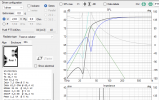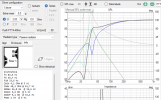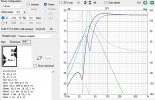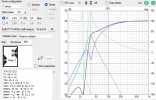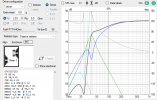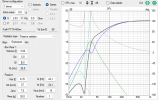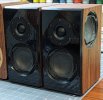Glorfindel
New Member
- Joined
- Dec 23, 2022
- Messages
- 4
- Likes
- 1
Hello all, I am Gian and I am new here. 
I would like to embark on my first "serious" DIY project. But before I sink a ton of money in a project that may be doomed from the start, I would appreciate some feedback from more experienced people on whether what I have in mind makes any sense. I hope it is fine for a newbie to just arrive on the scene like that and ask for your advice. In return, I would of course be happy to report on the progress and final result of the project.
Maybe two, three words about myself before I explain my plan:
I am from Switzerland and am doing a PhD in electrical engineering at ETH Zurich (not related to anything audio at all, though, so don't overestimate my expertise ). I have built several DIY kits before and even developed my own loudspeaker as my high school diploma project (which, with hindsight, thought me more about how loudspeakers should not be developed), so I am not a complete newbie. All in all, I feel like I am at a place where I can come up with some project plan on how to develop a speaker myself, but I am sure that this plan contains at least a few bad ideas. Any advice that helps me find and avoid these mistakes would be much appreciated.
). I have built several DIY kits before and even developed my own loudspeaker as my high school diploma project (which, with hindsight, thought me more about how loudspeakers should not be developed), so I am not a complete newbie. All in all, I feel like I am at a place where I can come up with some project plan on how to develop a speaker myself, but I am sure that this plan contains at least a few bad ideas. Any advice that helps me find and avoid these mistakes would be much appreciated. 
Okay, let's talk business. I like small speakers (this fact is not up to discussion), and I would like to get the best possible sound from a small box. Budget constraints are secondary, though I wouldn't want stuff to be gratuitously expensive. The ability to play high volumes is also less important, but I want to have good bass extension.
What I had in mind is to build an active two-way speaker with a passive radiator (PR) and a digital crossover in a ~5 liter box. For the woofer, I had my eyes set on one of the 4-inch Purifi drivers (4Ohm or 8Ohm). For the PR, I also thought of the 4-inch PR from Purifi. To achieve good directivity, I had planned to use a 4-inch waveguide from somasonus, which I would have 3D-printed. The availability of 4-inch waveguides would limit the choice of the tweeter to a SB21 or SB26 from SB Acoustics or the CSS LD22. For the crossover, I planned to use a miniDSP flex, and amplification would be provided by something like a 4-channel Buckeye amplifier. This component list makes clear that the whole project would easily land in the $3K ballpark, so not exactly cheap.
My naïve mind would imagine the development to look something like this:
I order a Purifi woofer and PR, a tweeter (my current favorite, without any solid reasons for this, would be the CSS LD22), a miniDSP flex and a UMIK-1 measurement mic. I toy around with VituixCAD to get the enclosure dimensions based on the TSP of the Purifi woofer. I have the waveguide 3D-printed and build a box prototype based on the VituixCAD simulations. I measure the woofer and the tweeter within the box prototype and twiddle with the filters of the miniDSP Flex until I am happy. I order the remainder of the component and build the "camera-ready" speakers.
I am pretty sure that it won't work like that. The problem is that I cannot really tell where reality will deviate significantly from the above outline.
Here are several difficulties of which I am already acutely aware:
 .
.
Any kind of response would be much appreciated!
Cheers,
Gian

I would like to embark on my first "serious" DIY project. But before I sink a ton of money in a project that may be doomed from the start, I would appreciate some feedback from more experienced people on whether what I have in mind makes any sense. I hope it is fine for a newbie to just arrive on the scene like that and ask for your advice. In return, I would of course be happy to report on the progress and final result of the project.
Maybe two, three words about myself before I explain my plan:
I am from Switzerland and am doing a PhD in electrical engineering at ETH Zurich (not related to anything audio at all, though, so don't overestimate my expertise
Okay, let's talk business. I like small speakers (this fact is not up to discussion), and I would like to get the best possible sound from a small box. Budget constraints are secondary, though I wouldn't want stuff to be gratuitously expensive. The ability to play high volumes is also less important, but I want to have good bass extension.
What I had in mind is to build an active two-way speaker with a passive radiator (PR) and a digital crossover in a ~5 liter box. For the woofer, I had my eyes set on one of the 4-inch Purifi drivers (4Ohm or 8Ohm). For the PR, I also thought of the 4-inch PR from Purifi. To achieve good directivity, I had planned to use a 4-inch waveguide from somasonus, which I would have 3D-printed. The availability of 4-inch waveguides would limit the choice of the tweeter to a SB21 or SB26 from SB Acoustics or the CSS LD22. For the crossover, I planned to use a miniDSP flex, and amplification would be provided by something like a 4-channel Buckeye amplifier. This component list makes clear that the whole project would easily land in the $3K ballpark, so not exactly cheap.
My naïve mind would imagine the development to look something like this:
I order a Purifi woofer and PR, a tweeter (my current favorite, without any solid reasons for this, would be the CSS LD22), a miniDSP flex and a UMIK-1 measurement mic. I toy around with VituixCAD to get the enclosure dimensions based on the TSP of the Purifi woofer. I have the waveguide 3D-printed and build a box prototype based on the VituixCAD simulations. I measure the woofer and the tweeter within the box prototype and twiddle with the filters of the miniDSP Flex until I am happy. I order the remainder of the component and build the "camera-ready" speakers.
I am pretty sure that it won't work like that. The problem is that I cannot really tell where reality will deviate significantly from the above outline.
Here are several difficulties of which I am already acutely aware:
- Should I go for the 4Ohm or the 8Ohm variant of the Purifi woofer? What are the relevant criteria here?
- What are the criteria based on which to decide between the three tweeter options? Will any of these tweeters even work well in combination with the Purifi woofer?
- Will some basic TSP-based simulations in VituixCAD really give me a good enough estimate so that I only have to design one enclosure prototype and the bass response will be as expected?
- Can I in fact just trust the TSP as published by Purifi? The reviews from Erin and from Hifi-Compass (both only for the 4Ohm variant) have measured parameters which do not match perfectly with the manufacturer's datasheet, as far as I understand. Would it make more sense to buy something like this and try to measure the TSP parameters myself? I have already toyed around with some simulations based on the manufacturer-supplied parameters of the 8Ohm woofer and the PR. A screenshot of the result is attached below.
- What about the design of the front? How wide and high should the front be, where should the drivers be placed on it, and should the front contain any fancy edge designs instead of simple rectangular edges? (I would like to avoid trial-and-error box prototypes, if at all possible.)
- How can I even check if the actual low-end response of the boxed speaker matches the simulations? Windowed at-home measurements won't work for low frequencies. We do have an "anechoic" chamber at our university department, and I guess that I could guess access to it if that would be helpful, but as far as I know the "anechoic" also only holds for frequencies above 100Hz or so...
- Will a 4-inch Waveguide from Somasonus even give me a matching directivity with a 4-inch woofer from Purifi, or are there other things to take into consideration of which I am completely unaware?
- What else am I missing?
Any kind of response would be much appreciated!
Cheers,
Gian



